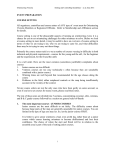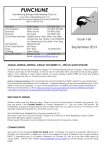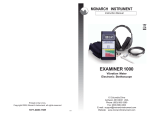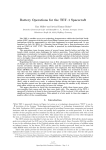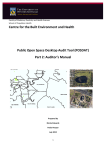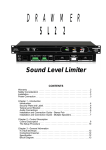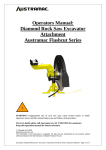Download Course setting and controlling guidelines
Transcript
Orienteering Victoria Setting and Controlling Guidelines – as at May 2014 EVENT PREPARATION COURSE SETTING Course setting is one of the pleasurable aspects of running an orienteering event, it is a chance for you to set orienteering challenges for other orienteers to solve. Before we look at course setting in more detail, it may be useful to have an overview of course setting in terms of what we are trying to do, who we are trying to cater for, and what difficulties there may be in trying to carry out these things. Primarily the course setter’s task is to set a number of courses varying in difficulty in both technical and physical requirements - courses for the young and the old, for the beginner and the experienced, for the fit and the unfit. Here are the most common complaints about courses 1. Easy/Moderate courses are too difficult 2. Veterans courses are too easy technically (often because they are unsuitably combined with a junior course ) 3. Winning times are well beyond that recommended 4. Problems in the field; either misplaced controls or the map being insufficiently accurate in the vicinity of the control Novice course setters are not the only ones who have been guilty on some account; so even if you have set courses for many events, please read these notes. 1. Junior Courses (Easy/Very Easy) Junior courses are the most important of all, and the most difficult to set fairly. The difficulty comes about because large parts of the map are generally unsuitable for junior courses. You are limited in the type of legs you may set. So, set the junior courses FIRST. It is better to give senior orienteers a bad leg, rather than set a junior course which causes learning orienteers to become disillusioned and lose their confidence. The choice of where the start and finish will be in relation to the assembly area is part of the task of setting junior courses. Look at the individual legs critically, asking yourself, § § § Can a junior (of the appropriate class) really do this? Could I do this leg if there was no brown on the map and all the point features had disappeared? If I got lost where might I end up if I could only relocate on big linear features? 1 Orienteering Victoria Setting and Controlling Guidelines – as at May 2014 What may appear as waist high bracken to you, could be an impenetrable jungle to a junior. If you can answer these questions satisfactorily the juniors will probably have an enjoyable day. § 2. Moderate courses These are too often regarded as the poor relation courses; but they are as important as all other courses and should be set before, and separately to, the Hard courses. Competitors are generally juniors transitioning from Easy to Hard standard, or adult newcomers – both groups than need a course that provides confidence, encouragement and enjoyment. Be careful not to set a poor course by taking the easy way out and using an ill assortment of controls from other courses; and avoid making the course too long because it is “easy”. 3. Courses for veterans (eg State Series course 4 and 5) While course lengths for some veterans classes are similar to those of some of the junior courses, a course good for one is unlikely to be good for the other. Veterans seek technically hard courses - they do not need catching features behind each control and they should not have controls on major handrails. But do set courses which are not too physically demanding, have not too much climb, avoid dense vegetation and an excess of rocks or broken ground, and do not require 20/20 vision to decide what features are really in the control circle. 4. Hard courses (eg State Series course 1-3) If you normally run (or used to run) an A course in younger age classes with confidence in your orienteering skills, you will know the technical standards required for that course. If you are trying to set a course technically harder than your accustomed level, the first thing to do is to look at some examples and get some comments from people who ran on the courses. If you don't know where to start, one way is to find a number of good long routechoice legs anywhere on the map. Then, bearing in mind the cautions given in section 5 below, try to link a few of these long legs, using some good short legs. If the map contains a variety of terrains, try to incorporate them all into the course. Do not have too many gift control sites, ie. avoid having controls just beyond a strong linear feature, and remember that a well defined spur or gully is as easily recognised as a major track to an elite orienteer. If you doubt your ability, get someone to go over your proposed courses with you. The controller should be prepared to do this. 2 Orienteering Victoria Setting and Controlling Guidelines – as at May 2014 General rules of thumb 1. Before starting any work on courses, work out target course lengths for all courses. Start with Course 1 and use percentages given in the Course Tables. Use past events as a guide to the speed of competitors on each course. Course lengths from previous events can be a guide, but look up the results to see if the times were OK. 2. Include a mix of short, medium and long legs and a variety of terrains if possible. 3. If, on all your route-choice legs, all feasible routes are equally good, the orienteer who does not think is not penalised. So include some legs where some routes are better than the others (but so that this is not too obvious). 4. Avoid dog-legs. A more general rule is that exit routes from a control should not be any of the reasonable approach routes to the control. This applies regardless of how many courses pass through the same control. An obvious dog-leg occurs where the competitors on a course approach and leave a control by the same route, an indirect dog-leg occurs when different courses use a common control but approach and leave in opposite directions. 5. Don't have too many people through a common control; the more difficult the navigation in the area of the control the more important this is. The courses through a common control should be of approximately the same standard. 6. If you cannot give an unambiguous IOF control description then the control site is no good. For example, suppose you want to use the NE boulder in a group of boulders. If when you draw the circle at the correct size, there is another boulder in the NE sector, the control site is no good. Generally, this means that in an area with lots of boulders, a boulder will not be a suitable control site; however another feature, perhaps a cliff or a small gully may be there and the orienteer will still have to read the boulder detail to navigate to the control. 7. Choice of the Start a) It should be impossible for waiting competitors to observe any routes chosen by those who have started. b) Two start areas may sometimes be needed; (eg, to cater for juniors and separately to give older orienteers the benefit of a downhill event). 3 Orienteering Victoria 7. Setting and Controlling Guidelines – as at May 2014 The first leg should not be too demanding, neither physically nor technically, the competitors should be given an opportunity to become acquainted with the map and the type of terrain. 8. On any course the last control should not be more difficult than average; as the last control is often common to many courses, set the last control to the standard of the least difficult class through the control. Keep the distance from the last control to the Finish as short as possible. Plan the courses so that they all approach the Finish from the same direction. WATER ON COURSES Please refer to separate Water Health and Safety document, and to Course Tables, which set minimum provisions for water on courses. SUMMARY OF TECHNICAL STANDARDS Very easy: Course must follow handrails (tracks, creeks, but no contour handrails); use large obvious features along handrails as control sites use many controls. A control must be placed at every decision point. A compass should not be necessary. Easy: Allow (in addition to above), easy contour handrails. Control sites may be large, obvious features just off handrails. A compass may be needed but accurate bearings not required. Some route choice may be given (eg follow handrails around or cut across country). Back up features essential for any cross country legs. Moderate: Cross country legs with route choice and good attack points close to control; catching features behind the control. Compass bearings and pace counting may be required. Easily-identified point features may be control sites. Hard: Navigation and route choice as difficult as possible; use small point features having no obvious attack points. Catching features not required. 4 Orienteering Victoria Setting and Controlling Guidelines – as at May 2014 Summary for Very Easy to Moderate Courses GRADE DISTANCE GENERAL TECHNICAL REQUIREMENTS LEGS Very Easy Not over 2 km 1. This course can never be too easy 2.Entire course must be navigable without a compass bearing 3. No pacing required 4. No contour recognition required 5. Key process is map orientation 1. Not over 300m long 2. Short legs with a large number of controls are more interesting and satisfying. Confidence is bolstered by viewing a control soon after leaving the previous one. 3. Entire course must be on strong handrails. Eg. Roads, tracks, intact fences, well defined watercourses. 4. If the nature of the map forces the use of a leg without a handrail, or with a handrail going only part of the way, then a streamer trail must be laid for the entire length of the leg. 5. There should be only one obvious route for each leg. 6. Where there is a critical turning point or where a transfer is made from one linear feature to another , there must be a control marker Easy Not over 3 km 1. Entire course must be navigable without a compass 2. Simple distance estimation on short courses can be expected 3. No contour recognition required 4. Key process is map orientation 1. Not over 400m long 2. Although the entire course must be navigable on handrails if the competitor so chooses, there should be some small route choice (eg. cutting a corner between tracks), but the distance involved should very small, and runability and visibility good. 3. If the nature forces the use of a leg without a handrail, or with a handrail going only part of the way, then a streamer trail must be laid for that portion of the leg where there is no handrail. 4. The competitor may be expected to turn corners or switch from one linear feature to another without a control marker at the transfer point. 5 Moderate Not over 4 km 1. Small stretches of rough compass running and fine bearings up to 100m may be expected 2. Recognition of very obvious contour features eg. large gull, may be expected 3. Pacing may be expected 1. Not over 600m long. 2. Route choice should be offered on most legs. 3. Linear features are required as alternative, but less attractive , options. Choice of direct cross country routes should be rewarded. 4. Cross country legs without a handrail option may be used, but only if necessary and easy. Orienteering Victoria Setting and Controlling Guidelines – as at May 2014 CONTROL SITES 1. Must be either part of the 1. Must be either part of the 1. Use isolated point handrail (eg. “track bend”, handrail (eg. “track features only if they are “fence corner”), or an bend”), or a point feature prominent, have strong obvious point feature on or beside the handrail, attack points on linear actually on or beside the or a large point feature features, and the line handrail. In the latter visible from the handrail bearing distance is less case, a small clue can and not more than 50m than 100m. accompany the control from it, with an obvious 2. Every control site must description (eg. “wreck in attack point on the have a linear catching track”, “mound beside handrail. feature behind it. road). 2. Place marker on the 3. Markers may be placed 2. Place marker on the approach side of control on the distant side of approach side of control sites. controls. sites. 3. These control sites must 4. Control sites may also be 3. These control sites must not also be used on senior used on senior courses. not also be used on senior courses (but may be used courses (but may be used on the Moderate course). on the Easy course). CONTROLLER FOR EVENTS 1. APPOINTMENT OF CONTROLLER A controller shall be appointed for all events of State Series standard and higher and any other events that Orienteering Victoria or OA nominates. For national and international events, the Controller shall be appointed by OA or IOF and shall be regarded as an agent of that authority. For Orienteering Victoria events, the Bush SubCommittee shall appoint a controlling club to control an event. It is the responsibility of that club to nominate the controller. If the club responsible fails to nominate a controller, the club running the event may appoint an internal controller of level 2 standing or above, for up to 50% of their events. Badge events and above must however have an external controller. Note that if a club is reduced to providing its own controller, then the club that was to provide the controller will be levied $2.00 per competitor and this money will be passed to the club organising the event. The controller shall be considered an agent of Orienteering Victoria. For events of lesser standard (Club, Parkland, and other minor events) the organising club shall appoint a suitable Controller and publish this in Coming Events. Controllers for these events may be members of the organising club. 6 Orienteering Victoria Setting and Controlling Guidelines – as at May 2014 2. RULES AND STANDARDS In general, the normal rules and standards for the conduct of orienteering events in Victoria are those set out in the OA “Competition Rules and Standards for Orienteering Events”. It is essential that Controllers are familiar with the current versions of these rules and standards. Also be familiar with the notes on safety, checklist for organisers of orienteering events and the recommended search procedures as specified in the club directory. Additional or special rules and standards may be approved for special events such as the Australian Championships and Controllers of these events should ensure that the additional conditions are observed. For minor events, the organising club may elect to set special rules (eg. for novelty events). These special rules shall be subject to the approval of the Controller and the club must make them known to potential competitors before the day of the event. For all events of higher level or to which OV (or OA) has appointed a Controller, any proposed variations from the OA Rules and Standards must be supplied to the Controller with adequate notice for a decision to be taken as to whether the proposed changes are acceptable. Controllers may use their discretionary power to authorise minor deviations from the normal rules and standards for State Series level events provided that the changes do not contravene the “fair play” and “equal advantage” principles. Permission for substantial deviation should be sought from the Bush Orienteering SubCommittee Coordinator. 3. COMMUNICATIONS It is essential that the event organisers and controller meet at the earliest stages of event planning. In the case of events with new maps, the Controller should be involved during mapping if possible, unless a separate Map Controller has been appointed. In all instances the schedule for organising and controlling an event must allow for any necessary changes requested by the Controller to be implemented and checked before the event. As a general guide, the Controller should be supplied with everything needed for him or her to carry out his job as set out in the timeframe of the controller’s checklist. Any suggestions for changes should, in the first instance, be discussed by the Controller with the organisers and course setters. 7 Orienteering Victoria Setting and Controlling Guidelines – as at May 2014 The basic design of courses is a matter for the course setter. The controllers role is to check for inaccuracies and inconsistencies that contravene the rules or standards or expose competitors to unnecessary danger. 4. DISPUTES It is hoped that most differences of opinion can be resolved by good will and common sense amongst the parties involved. If a serious difference persists then the advice of the Bush Orienteering SubCommittee Coordinator should be sought promptly. If the timeframe for the event is not complied with then the Bush Orienteering SubCommittee may find it necessary to downgrade the standard of the event after consultation with the controller. Controllers of events of State Series standard and higher are asked to provide a short written report on the event to the Bush Orienteering SubCommittee of the controlling Authority. EVENT CHECKLIST for Controllers and Course Setters 1. GENERAL The Controller is responsible for the quality of the event, especially the quality of courses. It is essential that the controller ensures that the course setter follows the timeframe set out below so that it enables submitted courses to be amended or changed if they are found to be technically incorrect or not to standard. It is important to contact the Bush Orienteering SubCommittee Coordinator as soon as possible if you can foresee any problems regarding the running of the event or in the course setters inability to follow the timeframe. It is important that the Controller attend the event and be available to join the protest jury if necessary. The controller needs to ensure that the organiser has attended to all aspects listed on the Organisers Checklist. 2. TIMEFRAME 2.1 Three months prior to event 2.1.1 The Assembly Area - Check the following a. Access to assembly/parking area by competitors and especially a contingency plan in the event of bad weather. b. Adequate parking 8 Orienteering Victoria Setting and Controlling Guidelines – as at May 2014 c. d. e. f. Adequate area for assembly/registration Suitability for novice/junior courses - handrails Suitable start/finish area Permission obtained to use/cross private land or use other facilities that are not totally public (eg. sports grounds, halls etc.) g. Obtain permission from the relevant authority or landowner h. Ensure that there is no conflict with other activities (car rally, Army exercise etc). 2.1.2 Conceptual Courses - Obtain from Course Setter conceptual view of each course, showing how the course will flow. No tags should be placed in the forest until conceptual courses have been checked. Use Appendix A as a guide and check the following a. Recommended age groupings b. Are course lengths suitable for this age group. c. How were course lengths calculated d. Are courses of a suitable standard It helps to give the course setter written comments regarded courses. However, it is not the controllers job to reset courses. Neither course setter or controller should commit themselves to specific control sites at this stage. In granite, only 50% of originally selected sites may be suitable, and 80% in spur gully. After the conceptual courses have been checked to your satisfaction, the course setter may then tag all sites with bright tape and writing on each tape the control code and control description with a permanent pen. 2.2 8 - 6 Weeks prior to the event 2.2.1 Obtain the following from the course setter a. Master maps with all sites marked b. Master clue description c. Copies of individual courses 2.2.2 Check individual courses a. Ensure that not too many competitors/courses are visiting the one control site. b. Controls are not too close together c. Course setter has checked where drinks are to be placed. In general, they should be placed at control sites and not between controls. 9 Orienteering Victoria d. Setting and Controlling Guidelines – as at May 2014 Close controls should be on different types of features and have different code and punch symbols (ie Close controls on gully and watercourse are wrong, spur and gully are okay). 2.2.3 Field Checking. Visit all control sites, from two directions, approaching and leaving is usually sufficient. Check the following: a. All relevant attack points are accurately mapped b. There are no obvious unmapped feature which may confuse competitors. c. Control description is fair and accurate and completely unambiguous. d. If necessary, recommend position and height of marker so that visibility is in accordance with the relevant standards. e. Code and control description on the tag is correct. Note. Allow for age and experience of competitors. A pit may be a major obstacle for small children or older competitors, but no problem for elites. For children’s courses, check visibility and runability at child’s eye level. If on checking, the controller is not satisfied with a proposed site, they should identify a nearby feature which is suitable and preserves the proposed courses as nearly as possible. 2.3 6 - 4 Weeks prior to event. 2.3.1 Course Aspects. Most errors occur in the paperwork side of course setting. Controllers should make up from the courses and clue sheets their own master maps and clue sheets. These should then be independently checked against the organizers info. It is essential that the controller check all of the following against each other: a. Individual courses b. Individual clue sheets c. Master map with controls d. List of control descriptions International clue sheets are best done using the computer program “Condes” or similar program. “Condes program and user manual is available from the OV Secretary on a disc exchange basis (Australia wide licence for clubs has been paid by OA). Also refer to the IOF Control Description Symbols - Australian Edition. 10 Orienteering Victoria Setting and Controlling Guidelines – as at May 2014 2.3.2 Organisational aspects. It is the controller’s responsibility to check with the organisers that the following things have been done. It is up to the organiser to satisfy the controller that the proposed arrangements are adequate. a. Signposting to the event venue should be as stated in the coming events listing. b. A sufficient number of toilets must be provided at the assembly area and at the start if it is a considerable distance away. In some areas, regulations may require that chemical toilets are used. c. Handout sheet should contain all relevant information for the event, including courses, fees, distance, map corrections, out of bounds areas etc. d. Check that there are sufficient personnel listed on the roster to ensure smooth operation of the event and rapid posting of the results. e. If a manned control is shown on the clue sheet, it should always be manned. 2.4 Two weeks prior to event Check one master map from each course against the map showing all controls and the clue sheet against the master clue description sheet. Then check the remainder of the master maps against the correct map. Also make sure that: a. A clue sheet is fixed to each master map. b. Map corrections and water, if away from control sites, are also marked on the master map as well as on a separate map for map corrections at registration (or on all premarked maps). c. A set of master punch cards has been made up. Event information – make sure that all event information including directions, course information etc, are posted onto the Orienteering Victoria website and included in the electronic O-News Bulletin. Take this opportunity to promote your event with any special arrangements, photos etc. 2.5 The day before the event The Controller is the person responsible for ensuring that the controls are correct when the event is held. Most controllers like to check every marker personally after it has been placed for the event. Some are prepared to rely on the members of the organising club checking the sites (pre-running the courses). Whichever of the above methods that you use, it is important that the following are checked: a. Which side of the feature has the control been placed. 11 Orienteering Victoria b. c. d. e. f. 2.6 Setting and Controlling Guidelines – as at May 2014 Is it hidden and therefore unfair. Have all tags been collected. Are both punches on the stands in working order Are any streamers or taped routes easily seen from a junior’s point of view. Has water been placed at all selected positions. Attendance at the event The controller should be in attendance at the event. If the controller or organiser becomes aware of a situation seriously affecting the fairness of a course, they have the right to cancel the course without waiting for a formal protest. Competitors may protest about any actions by the organisers. 2.6.1 Protest Jury. At State Series events or higher, the jury shall comprise of three voting members plus the organiser and controller (neither of whom have a vote). The voting members shall be a member of the Bush Orienteering SubCommittee (who shall act as Convenor) and two orienteers from outside the organising club, both of whom have previously course set or controlled an State Series event. 2.6.2 Final checks on the day of the event. a. Signposts are out and correctly placed. b. The start is clearly signposted from the assembly and registration areas. c. Master maps okay - are there enough red or purple biros? d. Finish chute - is it safe and clear? 2.6.3 Five Minute Prestart. This always causes problem, check carefully the following: Prestart Clock is EST (eg 10.00 am) Master Map Clock is Prestart Clock - 5 minutes (eg 9.55 am) Finish Clock equals Master Map Clock (eg 9.55 am) POSSIBLE PROBLEMS WITH PROPOSED COURSES The courses should be designed to make best use of the map whilst remaining appropriate to the age class. The following points normally detract from achieving this 1. Dangerous Areas Are there specific dangers (eg mine shafts) or dangerous areas that should especially be avoided by the orienteer? If so 12 Orienteering Victoria Setting and Controlling Guidelines – as at May 2014 - ensure that courses avoid crossing these areas - ensure that the club/organiser tape ALL dangerous mineshafts. Novices and juniors should not be taken into areas which present such dangers. 2. Dog Leg The route choice to or from any one control site should not enable competitors LEAVING the control to aid those approaching to find it more easily. 3. Clashing courses/controls The same control should not be used on two different courses where those courses leave/approach the control site from opposite directions. This has the same effect as a dogleg (leading competitors into the control. 4. Controls in close proximity to each other In general, controls on features of similar appearance should be at least 100 metres apart and no control should be within 25 metres of any other. - Check that they are not on similar types of features eg boulders and rocky ground. - Check that the codes are different enough so that competitors could not easily mispunch the control. - Check that the punch symbols on adjacent controls are different from each other. 5. Common controls Check that common controls are not too common (too many competitors increase the possibility of leading others into the control). 6. Lost Kilometers Long legs should occur on long courses, but they should not allow the competitor an easy navigational run (where fitness becomes the main test) 7. Shape of the Course The shape of the course is important a. It should not encourage the taking of controls out of order b. A variety of angles should be used when leaving the control to make it harder c. Care should be taken when setting "figure of eight" courses, manned controls may be used to prevent competitors from taking controls out of order. 8. Courses for Older Age Groups These courses should be navigationally challenging, but should avoid a. Steep areas without route choice to avoid climb. b. Use of control sites in complex areas that are hard to read on the map. 13 Orienteering Victoria c. 9. Setting and Controlling Guidelines – as at May 2014 Very thick or rough areas. Novice Courses These courses are the hardest to set properly. Remember an area that seems easy to you may be very different at a child's eye level. Courses normally follow linear features, however use as many individual types of features as possible (this encourages the use of and an increased understanding of the map). Use streamers or string to tape difficult sections. See further notes on string courses. 14














